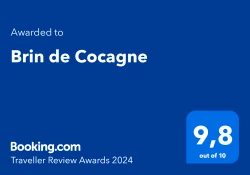Since my arrival in the Tarn, I regularly heard about the « Pays de Cocagne » and « pastel » … After reading many articles and documents, my knowledge had gone beyond the stage of the « mât de cocagne » with its ribbons and « pastel », the pigment I have used for many years to paint my pictures…
A few weeks ago, when I received Brigitte Lesage, owner of the Buc estate, my curiosity was further aroused when she urged me to visit the « Pastel de la serre estate ».
So, on Monday 22 March, I got into my car and headed for the Cocagne region. After 45 minutes of small roads along soft landscapes of hills in this early hour, I arrived in front of a castle worthy of the « Sleeping Beauty », surrounded by beautiful stone buildings.
Bruno Berthoumieux, one of the descendants of this beautiful pastel story did me the honour of telling me more…
Pastel has been known since antiquity for its therapeutic and healing properties.
Pastel was brought to Europe by the Moors. In 1524, Saint-Louis decided to support the trade when he returned from a crusade. Louis IX made pastel the colour of court clothing. It is legendary to say that Saint Louis was struck by the special blue colour of the Virgin’s veil. This is how pastel has transmitted a unique and powerful vibration for centuries.
Extract from the website: Pastel de la serre
The plant is called Isatis Tinctoria, better known by its Occitan name of “Pastel”. Its yellow flowers and green leaves are used to extract a very stable natural blue dye called “pastel”. The plant blooms from April to June. The leaves are picked by hand from St John’s Day to All Saints Day. They are then washed and crushed in a pastel mill.
The dough obtained is then put in a heap for a long time, turned regularly to ensure a first fermentation. It can then be kneaded and rolled into a ball or pear shape: the shells “cocagnes or coques”.
The shells are then crumbled, broken up and put back into a heap which is watered and turned regularly to ensure a second fermentation for several weeks. This is how the “agranat” is obtained.
However, to use it in dyeing, the indigo (i.e., the blue pigment contained in the woad) is not soluble in water and therefore cannot impregnate the textile fibres.
The « Cuve » consists of reducing the indigo in water, in an anaerobic (airless) and basic environment. Once reduced, the indigo becomes yellowish. The term « cuve » is used because in the past, this operation was carried out in a wooden or enamel vat.
The economic spin-offs of exporting to the North created the legend of the « Pays de Cocagne ». By definition, the Lauragais is the land of Cocagne. It is here, in fact, in this land of exceptionally fertile hills, that this famous expression was born. This mythical plant, the pastel, is very strongly associated with the history of the Lauragais.
Pastel gave the Lauragais region an unprecedented wealth from the 15th to the 16th century, a golden century (from 1462 to 1562) which saw the country covered with castles, churches and pigeon houses.
Extrait du site : http://cocagne.tourisme-tarn.com/en/pastel-perfect-blue
The « Pastel flower » collected on the edge of the dyers’ vats was used as a pigment for the Fine Arts, as the painters’ pastel could only tolerate very little oil and were used in powder form. It was not until the end of the 15th century that dry painting took off in France, and its use in « pencils » was proven.
After this beautiful story, Bruno Berthomieux took me on a tour of the estate, the castle, the plantations, the dovecote, the old buildings « l’indigoterie », the place where pastel was extracted and where cocagne was transformed into pastel.
I finished the visit with the shop full of small gifts, some of them unique and easy to take away.
I had just spent 2 hours without having seen pass the time … with a great story teller!
I cannot recommend you to take the time to visit this beautiful place!





